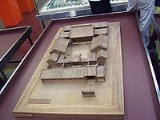
Siheyuan
Encyclopedia

China
Chinese civilization may refer to:* China for more general discussion of the country.* Chinese culture* Greater China, the transnational community of ethnic Chinese.* History of China* Sinosphere, the area historically affected by Chinese culture...
, most famously in Beijing
Beijing
Beijing , also known as Peking , is the capital of the People's Republic of China and one of the most populous cities in the world, with a population of 19,612,368 as of 2010. The city is the country's political, cultural, and educational center, and home to the headquarters for most of China's...
. In English, siheyuan are sometimes referred to as Chinese quadrangles
Quadrangle (architecture)
In architecture, a quadrangle is a space or courtyard, usually rectangular in plan, the sides of which are entirely or mainly occupied by parts of a large building. The word is probably most closely associated with college or university campus architecture, but quadrangles may be found in other...
. The name literally means a courtyard
Courtyard
A court or courtyard is an enclosed area, often a space enclosed by a building that is open to the sky. These areas in inns and public buildings were often the primary meeting places for some purposes, leading to the other meanings of court....
surrounded by four buildings. Throughout Chinese history, the siheyuan composition was the basic pattern used for residences, palaces, temples, monasteries, family, businesses and government offices. In ancient times, a spacious siheyuan would be occupied by a single, usually large and extended family, signifying wealth and prosperity. Today, many remaining siheyuan are still used as housing complexes, but many lack modern amenities.
History
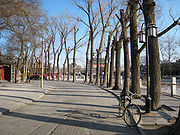
.jpg)

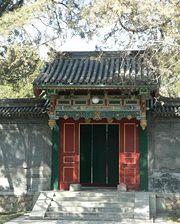
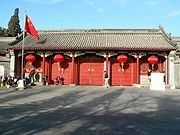
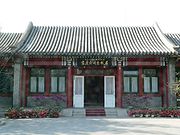
Zhou Dynasty
The Zhou Dynasty was a Chinese dynasty that followed the Shang Dynasty and preceded the Qin Dynasty. Although the Zhou Dynasty lasted longer than any other dynasty in Chinese history, the actual political and military control of China by the Ji family lasted only until 771 BC, a period known as...
period, and has a history of over 2,000 years. They exhibit outstanding and fundamental characteristics of Chinese architecture. They exist all across China and are the template for most Chinese architectural styles. Siheyuan also serves as a cultural symbol of Beijing and a window into its old ways of life.
Modern Beijing's population boom has made housing one of city's biggest challenges. Siheyuan today are typically used as housing complexes, hosting multiple families, with courtyards being developed to provide extra living space. The living conditions in many siheyuan are quite poor, with very few having private toilets. In the 1990s, systematic demolition of old urban buildings took place in Beijing under rapid economic development. Many siheyuan are being torn down to address the problem of overcrowding, and have been replaced by modern apartment blocks.
Present
According to the Beijing Municipal Administration of Cultural Heritage, there are over 500 historic courtyards preserved in the Cultural and Historical Conservation Areas as important cultural monuments. Many of these are public museums, and preserved historical siheyuans include Lu XunLu Xun
Lu Xun or Lu Hsün , was the pen name of Zhou Shuren , one of the major Chinese writers of the 20th century. Considered by many to be the leading figure of modern Chinese literature, he wrote in baihua as well as classical Chinese...
Memorial, Guo Moruo
Guo Moruo
Guo Moruo , courtesy name Dingtang , was a Chinese author, poet, historian, archaeologist, and government official from Sichuan, China.-Family history:Guo, originally named Guo Kaizhen, was born on November 10 or 16, in the small town of Shawan...
Memorial, Mao Dun
Mao Dun
Mao Dun was the pen name of Shen Dehong , a 20th century Chinese novelist, cultural critic, and journalist. He was also the Minister of Culture of China from 1949 to 1965. He is currently renowned as one of the best realist novelists in the history of modern China...
Memorial, Mei Lanfang
Méi Lánfang
Mei Lanfang was one of the most famous Beijing opera artists in modern history, exclusively known for his qingyi roles, a type of dan role. Méi Lánfāng is his stage name, and in Chinese it is generally considered a feminine name. His real name was Méi Lán...
Memorial, Lao She
Lao She
Shu Qingchun , better known by his pen name Lao She was a notable Chinese writer. A novelist and dramatist, he was one of the most significant figures of 20th century Chinese literature, and is perhaps best known for his novel Rickshaw Boy and the play Teahouse . He was of Manchu ethnicity...
Memorial and many others. A study by the United Nations Human Settlements Programme
United Nations Human Settlements Programme
The United Nations Human Settlements Programme is the United Nations agency for human settlements. It was established in 1978 and has its headquarters at the United Nations Office at Nairobi, Kenya...
in 2008 estimates that there are still about 400,000 residential courtyards remaining in Beijing. The sales market of siheyuan has also been booming in recent years. A report in 2005 finds there are usually around 7,000 to 9,000 residential siheyuans that are on the market for sale, and many are generally priced at 7,000 to 10,000 yuan per square meter. However, the prices vary based on the area and the market. For residential siheyuans in the Dongcheng and Xicheng districts in 2009, the prices can go up to 40,000 yuan per square meter. For siheyuans near the Houhai
Houhai
Houhai is a lake and its surrounding district in central Beijing, one of the three parts of Shichahai. In recent years it has become famous for nightlife because it is home to many popular restaurants, bars, and cafes....
and Shichahai
Shichahai
Shichahai is an historic scenic area consisting of three lakes in the north of central Beijing in China. They are located to the north-west of the Forbidden City and north-west of the Beihai Lake. Shichahai consists of the following three lakes: Qianhai , Xihai and Houhai...
area, the prices can go up to between 100,000 to 150,000 yuan per square meter. A 2,000 square meter siheyuan near the Shichahai area was sold for 40 million yuan ($6 million) in 2005.
Layout of Beijing siheyuan
The four buildings of a siheyuan are normally positioned along the north-south and east-west axes. The building positioned to the north and facing the south is considered the main house (正房 zhèng-fáng). The buildings adjoining the main house and facing east and west are called side houses (廂房 xiāng-fáng). The northern, eastern and western buildings are connected by beautifully decorated pathways (廊 láng). These passages serve as shelters from the sunshine during the day, and provide a cool place to appreciate the view of the courtyard at night. The building that faces north is known as the opposite house (倒座房 dào-zuò-fáng). Behind the northern building, there would often be a separate backside building (后罩房 hòu-zhào-fáng), the only place where two-story buildings are allowed to be constructed for the traditional siheyuan.The entrance gate, usually painted vermilion and with copper
Copper
Copper is a chemical element with the symbol Cu and atomic number 29. It is a ductile metal with very high thermal and electrical conductivity. Pure copper is soft and malleable; an exposed surface has a reddish-orange tarnish...
door knockers on it, is usually at the southeastern corner. Normally, there is a screen wall inside the gate, for privacy; superstition holds that it also protects the house from evil spirits. A pair of stone lions are often placed outside the gate. Some large siheyuan compounds would have two or more layers of courtyards and even private gardens attached to them. Such is a sign of wealth and status in ancient times.
The courtyard dwellings were built according to the traditional concepts of the five elements that were believed to compose the universe
Universe
The Universe is commonly defined as the totality of everything that exists, including all matter and energy, the planets, stars, galaxies, and the contents of intergalactic space. Definitions and usage vary and similar terms include the cosmos, the world and nature...
, and the eight diagrams
Bagua (concept)
The bagua are eight diagrams used in Taoist cosmology to represent the fundamental principles of reality, seen as a range of eight interrelated concepts. Each consists of three lines, each line either "broken" or "unbroken," representing yin or yang, respectively...
of divination. The gate was made at the southeast corner which was the "wind
Wind
Wind is the flow of gases on a large scale. On Earth, wind consists of the bulk movement of air. In outer space, solar wind is the movement of gases or charged particles from the sun through space, while planetary wind is the outgassing of light chemical elements from a planet's atmosphere into space...
" corner, and the main house was built on the north side which was believed to belong to "water
Water
Water is a chemical substance with the chemical formula H2O. A water molecule contains one oxygen and two hydrogen atoms connected by covalent bonds. Water is a liquid at ambient conditions, but it often co-exists on Earth with its solid state, ice, and gaseous state . Water also exists in a...
" -- an element to prevent fire.
The layout of a simple courtyard represents traditional Chinese morality
Morality
Morality is the differentiation among intentions, decisions, and actions between those that are good and bad . A moral code is a system of morality and a moral is any one practice or teaching within a moral code...
and Confucian ethics. In Beijing
Beijing
Beijing , also known as Peking , is the capital of the People's Republic of China and one of the most populous cities in the world, with a population of 19,612,368 as of 2010. The city is the country's political, cultural, and educational center, and home to the headquarters for most of China's...
, four buildings in a single courtyard receive different amounts of sunlight. The northern main building receives the most, thus serving as the living room
Living room
A living room, also known as sitting room, lounge room or lounge , is a room for entertaining adult guests, reading, or other activities...
and bedroom
Bedroom
A bedroom is a private room where people usually sleep for the night or relax during the day.About one third of our lives are spent sleeping and most of the time we are asleep, we are sleeping in a bedroom. To be considered a bedroom the room needs to have bed. Bedrooms can range from really simple...
of the owner or head of the family. The eastern and western side buildings receive less, and serve as the rooms for children or less important members of the family. The southern building receives the least sunlight, and usually functions as a reception room and the servants' dwelling, or where the family would gather to relax, eat or study. The backside building is for unmarried daughters and female servants: because unmarried girls were not allowed direct exposure to the public, they occupied the most secluded building in the siheyuan.
A more detailed and further stratified Confucian order was followed in ancient China. The main house in the north was assigned to the eldest member of the family, i.e. the head of the family, usually grandparents. If the main house had enough rooms, a central room would serve as a shrine for ancestral worship. When the head of the household had concubines, the wife would reside in the room to the eastern end of the main house, while the concubines would reside in the room to the western end of the main house. The eldest son of the family and his wife would reside in the western side house, while the younger son and his wife would reside in the eastern side house. If a grandson was fully grown, he would reside in the opposite house in the south. Unmarried daughters would always reside in the backside building behind the main house.
When a funeral is held in a siheyuan, the location of the casket depends on the status of the deceased, but all caskets are oriented so that the head of the deceased points south while the feet point north. If the deceased is the head of the househould or his wife, then the casket would be on the center line in the main house. If the deceased was the concubine of the head of the household, her casket would remain in the main house, but could not be in the center. If the deceased is a younger male, then his casket is placed on the center line of the courtyard. If the deceased is a younger female, her casket is placed in the courtyard but cannot be on the center line.
Though from antiquity, a siheyuan is a practically sound, engineered structure. Northwestern walls are usually higher than the other walls to protect the inside buildings from the harsh winds blowing across northern China
North China
thumb|250px|Northern [[People's Republic of China]] region.Northern China or North China is a geographical region of China. The heartland of North China is the North China Plain....
in the winter. Eaves curve downward, so that rainwater will flow along the curve rather than dropping straight down. The rooftop is ridged to provide shade in the summer while retaining warmth in the winter.
A siheyuan offers space, comfort, quiet and privacy
Privacy
Privacy is the ability of an individual or group to seclude themselves or information about themselves and thereby reveal themselves selectively...
. Siheyuan walls provide security as well as protection against dust and storms. With plants, rocks, and flowers, the yard is also a garden, and acts like an open-air living room. The veranda divides the courtyard into several big and small spaces that are not very distant from each other. Family members talked with each other here, creating a cordial atmosphere.
Siheyuan in other areas
In GansuGansu
' is a province located in the northwest of the People's Republic of China.It lies between the Tibetan and Huangtu plateaus, and borders Mongolia, Inner Mongolia, and Ningxia to the north, Xinjiang and Qinghai to the west, Sichuan to the south, and Shaanxi to the east...
, Qinghai
Qinghai
Qinghai ; Oirat Mongolian: ; ; Salar:) is a province of the People's Republic of China, named after Qinghai Lake...
and other northwest regions, where dust storm
Dust storm
A dust / sand storm is a meteorological phenomenon common in arid and semi-arid regions. Dust storms arise when a gust front or other strong wind blows loose sand and dirt from a dry surface. Particles are transported by saltation and suspension, causing soil to move from one place and deposition...
s are very strong, courtyard walls tend to be higher. The shapes of siheyuan are also altered: in northwestern China
Northwestern China
Northwestern China includes the autonomous regions of Xinjiang and Ningxia and the provinces of Shaanxi, Gansu, and Qinghai.-Administrative divisions:ProvincesAutonomous Regions-Outer Northwest China:...
, the north-south span of a siheyuan is generally much longer than the east-west span, while in other provinces such as Sichuan
Sichuan
' , known formerly in the West by its postal map spellings of Szechwan or Szechuan is a province in Southwest China with its capital in Chengdu...
, the opposite is true. In southern China, the houses are built with multiple stories. In the northeast, land is abundant but the weather is cold, so courtyards are built broad and large to increase the exposure to sunlight, and there are more open areas inside the walls.

